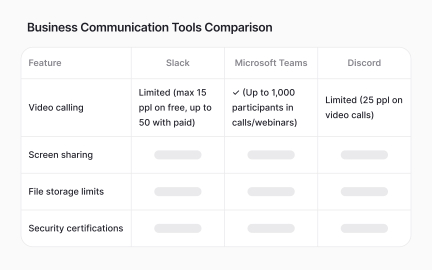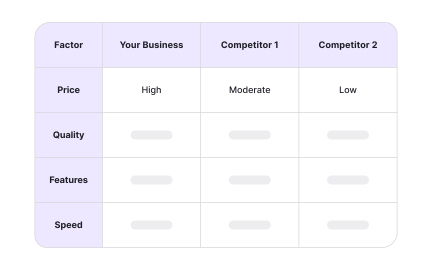Product Differentiation
Product differentiation highlights how a product stands out from alternatives, based on features, performance, design, or brand appeal.
What is Product Differentiation?
Your product struggles to justify premium pricing and customer loyalty because offerings are perceived as commodities that compete primarily on price, missing opportunities to create unique value propositions that justify customer preference and higher margins.
Most companies attempt differentiation through feature lists and marketing messages without systematic strategies for creating genuine competitive advantages that customers value enough to pay premium prices and remain loyal despite competitive alternatives.
Product differentiation is the strategic process of creating distinct competitive advantages through unique features, superior performance, better customer experience, or innovative approaches that make products meaningfully different from alternatives in ways customers value and are willing to pay for.
Companies with strong product differentiation achieve 35% higher profit margins, 45% better customer retention, and significantly improved competitive positioning because customers choose products based on unique value rather than just price comparison.
Think about how Apple differentiates through design excellence and ecosystem integration that justifies premium pricing, or how Tesla differentiates electric vehicles through performance and technology leadership rather than just environmental benefits.
Why Product Differentiation Matters for Competitive Advantage
Your business competes in commodity markets with price-sensitive customers because products don't offer meaningful advantages over alternatives, leading to margin pressure and customer relationships based on cost rather than unique value creation.
The cost of lacking differentiation compounds through every competitive interaction where unique value isn't apparent. You get price-based competition, customer churn to lower-cost alternatives, missed opportunities for premium positioning, and competitive vulnerability when alternatives offer similar functionality.
What effective product differentiation delivers:
Higher profit margins and pricing power because differentiated products justify premium pricing through unique value that customers can't find elsewhere, enabling better unit economics and business sustainability.
When differentiation is meaningful, customers choose products based on unique benefits rather than just price comparison, enabling strategic pricing and improved profitability margins.
Better customer loyalty and retention through differentiation that creates switching costs and customer satisfaction that competitors can't easily replicate, building sustainable competitive advantages.
Enhanced market positioning and brand strength because differentiation enables clear value communication and market positioning that resonates with target customers rather than generic positioning that doesn't motivate preference.
Improved competitive defense and market share protection as meaningful differentiation creates barriers to competitive substitution rather than commoditized offerings that are easily replaced by alternatives.
Stronger innovation direction and development focus through differentiation strategy that guides product development toward capabilities that create competitive advantages rather than just feature parity with competitors.
Advanced Product Differentiation Strategies
Once you've established basic differentiation capabilities, implement sophisticated competitive advantage and market positioning approaches.
Ecosystem Differentiation and Platform Advantages: Create differentiation through integrated product ecosystems rather than just individual product features, building competitive advantages that are harder to replicate.
Experience Differentiation and Customer Journey Optimization: Differentiate through superior customer experience and service rather than just product functionality, creating competitive advantages through interaction quality and satisfaction.
Technology Differentiation and Innovation Leadership: Build differentiation through proprietary technology and innovation capabilities rather than just feature differences, creating competitive barriers through technical advantages.
Market Positioning Differentiation and Brand Strategy: Differentiate through market positioning and brand communication rather than just product capabilities, creating competitive advantages through customer perception and market leadership.
Step 1: Analyze Customer Needs and Competitive Landscape (Week 1)
Research unmet customer needs and competitive gaps that create opportunities for meaningful differentiation rather than just feature comparison without strategic advantage identification and customer value assessment.
This creates differentiation foundation based on actual market opportunities rather than internal assumptions about what customers should value about your product capabilities and competitive positioning.
Step 2: Identify Unique Capabilities and Competitive Advantages (Week 1-2)
Discover organizational strengths, technology advantages, or market positions that enable differentiation that competitors can't easily replicate rather than just different features without sustainable competitive protection.
Focus differentiation on capabilities that create genuine customer value rather than just technical differences that might not matter for customer decision-making and satisfaction.
Step 3: Develop Differentiation Strategy and Value Propositions (Week 2)
Create systematic approaches to leveraging unique capabilities for customer value creation that justifies premium positioning rather than just being different without customer benefit and market advantage.
Balance differentiation ambition with practical implementation to ensure differentiation strategies can be executed effectively with available resources and organizational capabilities.
Step 4: Implement Differentiation Through Product Development and Market Communication (Week 2-3)
Execute differentiation strategy through product features, customer experience, and market positioning that communicates unique value clearly rather than hoping differentiation will be obvious without strategic communication.
Step 5: Maintain Differentiation Through Continuous Innovation and Competitive Response (Week 3)
Sustain differentiation advantages through ongoing innovation and competitive barrier building rather than just achieving initial differentiation without protection against competitive imitation and market evolution.
This ensures product differentiation generates sustainable competitive advantage rather than just temporary market positioning that doesn't protect against competitive response and market commoditization.
If differentiation doesn't improve competitive positioning, examine whether advantages address customer needs that actually influence purchase decisions rather than just product differences without customer value validation.
The Problem: Product differentiation that focuses on features and capabilities rather than customer outcomes and value creation that actually influence purchase decisions and customer loyalty.
The Fix: Differentiate based on customer value and outcomes rather than just product features, ensuring differentiation addresses customer decision-making criteria and satisfaction drivers.
The Problem: Differentiation strategies that can be easily copied by competitors rather than creating sustainable competitive advantages that are difficult or expensive to replicate.
The Fix: Build differentiation on capabilities and advantages that competitors can't easily copy rather than just surface-level differences that don't create sustainable competitive protection.
The Problem: Differentiation that doesn't connect to customer willingness to pay premium prices, creating unique products that don't generate improved business outcomes and profitability.
The Fix: Ensure differentiation creates value customers are willing to pay for rather than just being different without customer value validation and premium pricing justification.
Create product differentiation approaches that generate sustainable competitive advantage rather than just product differences that don't improve market positioning and business outcomes significantly.
Recommended resources
Courses

Product Discovery

Product Analytics






